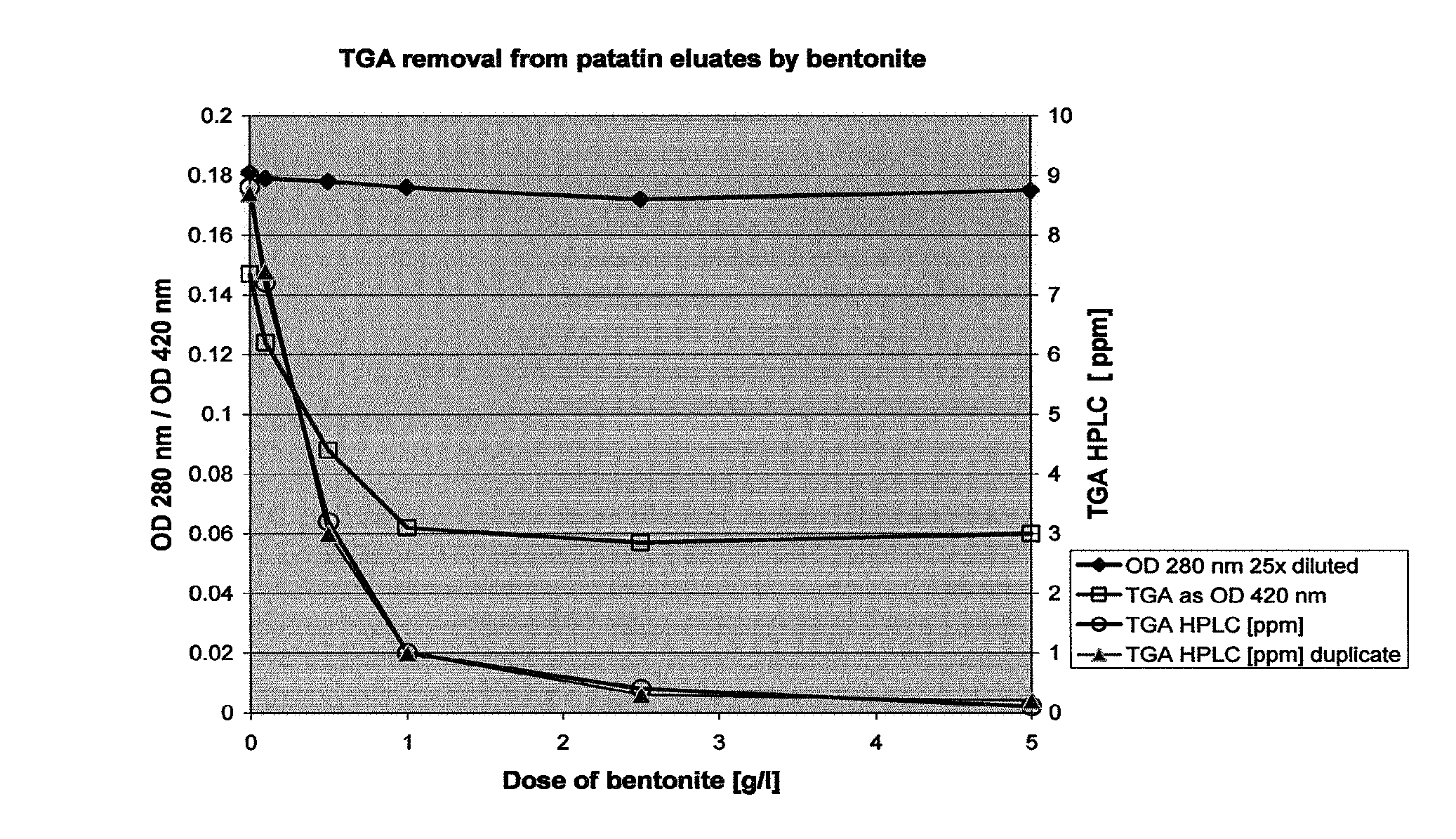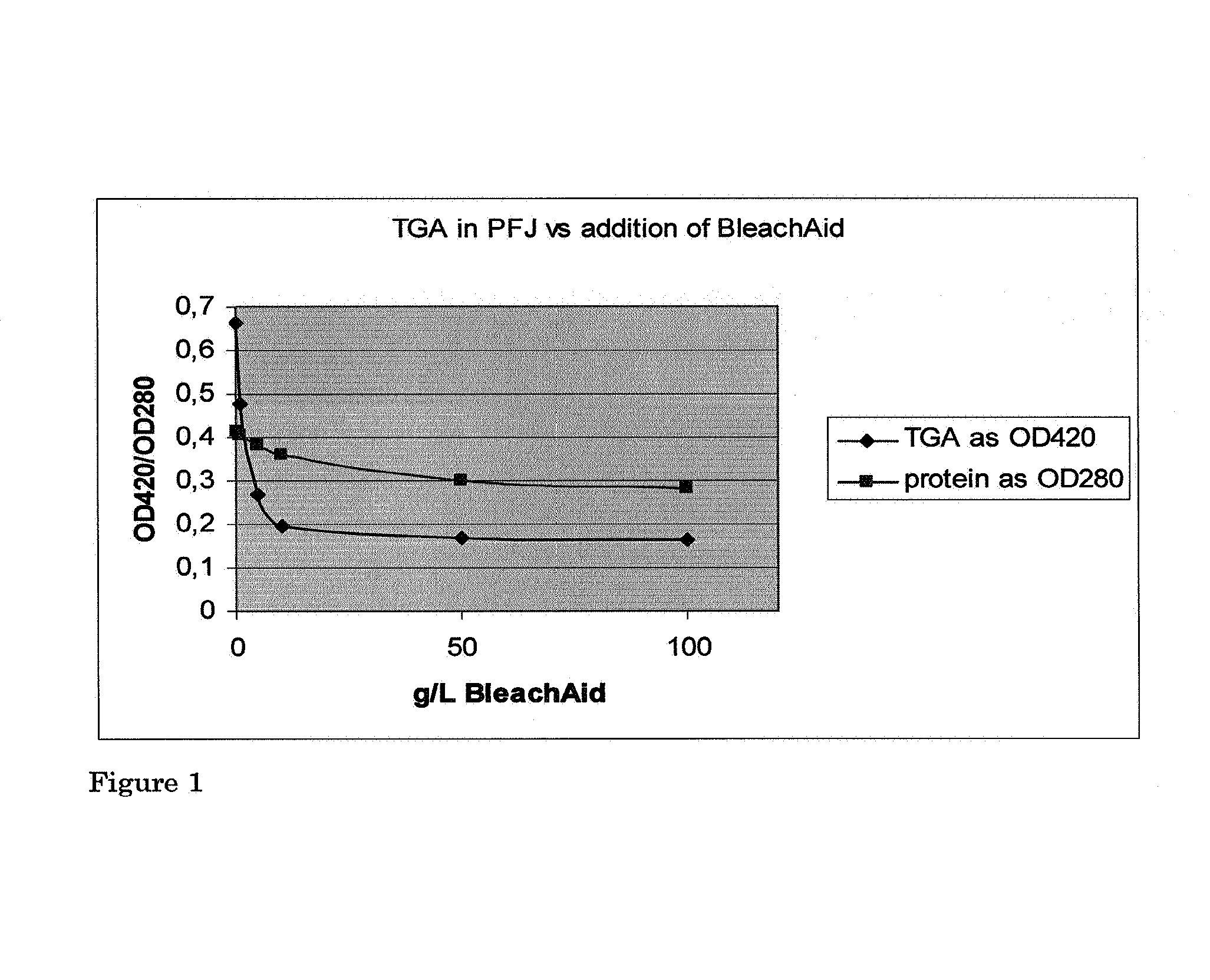Glycoalkaloid removal
a glycoalkaloids and glycoalkaloids technology, applied in the direction of vegetable protein working up, peptide/protein ingredients, peptides, etc., can solve the problems of limiting the application of known native potato protein isolates in foods, unable to detect aglycons formed by enzymatic hydrolysis, and complex separation and isolation of minimally denatured or modified potato proteins, etc., to achieve effective and complete removal of glycoalkaloids
- Summary
- Abstract
- Description
- Claims
- Application Information
AI Technical Summary
Benefits of technology
Problems solved by technology
Method used
Image
Examples
example 1
[0060]Fresh potato fruit juice from the potato variety Seresta was obtained from a potato starch factory at Ter Apelkanaal, The Netherlands. The potato fruit juice was obtained after the removal of starch and fibres. Various amounts of BleachAid™ (bentonite) (Engelhard) were added to 100 ml of potato fruit juice (0, 1, 5, 10, 50 and 100 g / l).
[0061]The liquids were shaken slowly at 180 rpm in a 250 ml shake flask for 4 hours at room temperature. After 4 hours the BleachAid™ was sedimented and decanted. The supernatant was analysed for protein and total glycoalkaloid levels. The protein was determined by measuring the optical density at 280 nm in 100 mM NaOH using an appropriate dilution. Total glycoalkaloid (TGA) levels were determined using a colorimetric assay and measuring the optical density of the alkaloid complex at 420 nm. Untreated potato fruit juice was used as reference. The results are summarized in Table 1 and FIG. 1.
[0062]
TABLE 1Effect of BleachAid ™ in TGA removalProtei...
example 2
[0071]Eluates containing protease inhibitors derived from the adsorption process as described in Example 1 method 10 of European patent application no. 06077000.5 were used as starting material. Solutions with initial pH values of 3.45 and 11.27 were used to start a pH range. The pH dependence of binding to BleachAid™ was tested. 10 ml protease inhibitors eluate with set pH were incubated during 2 hours with 0, 1 and 5 g / l BleachAid™ in a shake flask. The BleachAid™ was removed by sedimentation. The TGA and protein levels were determined as presented in table 3.
[0072]
TABLE 3Effect of pH on adsorption of TGA to BleachAid ™Protein asTGAOD 280 nmTGA as ODTGAreductionBleachAid ™Final(25×420 nmdelta ODas % in ODInitial pHadded (g / l)pHdiluted)Average**420 nm420 nm3.4503.450.4380.262013.450.4380.2350.02810.453.440.4240.1630.01037.94.4504.470.4200.247014.450.4170.2000.04718.854.440.4120.1600.08735.25.4505.440.4020.210015.430.3980.1600.05124.055.420.3900.1290.08138.46.4306.390.3990.208016.40...
example 3
[0074]Eluates with patatin derived from the adsorption process as described in Example 1 method 9 of European patent application no. 06077000.5 were set at pH 4.5; 5.5; 6.5 and 7.5. 10 ml sample was incubated with 5 g / l of the selected bentonite in a 15 ml falcon tube during 90 minutes while gently shaking at room temperature. All samples were centrifuged at 500 rpm (44×g) for 2 minutes as some bentonites did not sediment well. Two blanks without betonites were incubated in the same way. The TGA and protein levels were determined as presented in Table 4.
[0075]
TABLE 4Removal of TGA using various bentonites at various pHProtein asTGA aspH afterOD 280 nmOD 420 nmpH90 min25x dilutedAverageblank14.54.520.1480.1575.55.600.1770.1796.56.640.1680.1677.57.410.1670.148Tonsil ® supreme 112FF4.54.370.1030.0645.55.440.1170.0536.56.460.1460.0487.56.970.1550.065blank24.54.510.1445.55.590.1660.1076.56.610.1720.1007.57.420.1850.030Tonsil ® Optimum4.54.440.1620.020210FF5.55.520.1740.0276.56.520.1840.0...
PUM
| Property | Measurement | Unit |
|---|---|---|
| Fraction | aaaaa | aaaaa |
| Fraction | aaaaa | aaaaa |
| Particle size | aaaaa | aaaaa |
Abstract
Description
Claims
Application Information
 Login to View More
Login to View More - R&D
- Intellectual Property
- Life Sciences
- Materials
- Tech Scout
- Unparalleled Data Quality
- Higher Quality Content
- 60% Fewer Hallucinations
Browse by: Latest US Patents, China's latest patents, Technical Efficacy Thesaurus, Application Domain, Technology Topic, Popular Technical Reports.
© 2025 PatSnap. All rights reserved.Legal|Privacy policy|Modern Slavery Act Transparency Statement|Sitemap|About US| Contact US: help@patsnap.com



